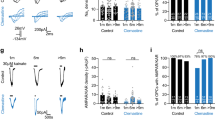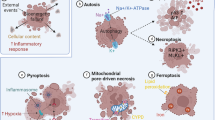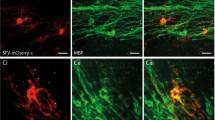Abstract
Injury to oligodendrocyte processes, the structures responsible for myelination, is implicated in many forms of brain disorder1,2,3,4. Here we show NMDA (N-methyl-d-aspartate) receptor subunit expression on oligodendrocyte processes, and the presence of NMDA receptor subunit messenger RNA in isolated white matter. NR1, NR2A, NR2B, NR2C, NR2D and NR3A subunits showed clustered expression in cell processes, but NR3B was absent. During modelled ischaemia, NMDA receptor activation resulted in rapid Ca2+-dependent detachment and disintegration of oligodendroglial processes in the white matter of mice expressing green fluorescent protein (GFP) specifically in oligodendrocytes (CNP-GFP mice). This effect occurred at mouse ages corresponding to both the initiation and the conclusion of myelination. NR1 subunits were found mainly in oligodendrocyte processes, whereas AMPA (α-amino-3-hydroxy-5-methyl-4-isoxazole propionic acid)/kainate receptor subunits were mainly found in the somata. Consistent with this observation, injury to the somata was prevented by blocking AMPA/kainate receptors, and preventing injury to oligodendroglial processes required the blocking of NMDA receptors. The presence of NMDA receptors in oligodendrocyte processes explains why previous studies that have focused on the somata have not detected a role for NMDA receptors in oligodendrocyte injury. These NMDA receptors bestow a high sensitivity to acute injury and represent an important new target for drug development in a variety of brain disorders.
This is a preview of subscription content, access via your institution
Access options
Subscribe to this journal
Receive 51 print issues and online access
$199.00 per year
only $3.90 per issue
Buy this article
- Purchase on Springer Link
- Instant access to full article PDF
Prices may be subject to local taxes which are calculated during checkout




Similar content being viewed by others
References
Back, S. A. et al. Selective vulnerability of late oligodendrocyte progenitors to hypoxia-ischemia. J. Neurosci. 22, 455–463 (2002)
Grossman, S. D., Rosenberg, L. J. & Wrathall, J. R. Temporal–spatial pattern of acute neuronal and glial loss after spinal cord contusion. Exp. Neurol. 168, 273–282 (2001)
Dewar, D., Underhill, S. M. & Goldberg, M. P. Oligodendrocytes and ischemic brain injury. J. Cereb. Blood Flow Metab. 23, 263–274 (2003)
Pitt, D., Werner, P. & Raine, C. S. Glutamate excitotoxicity in a model of multiple sclerosis. Nature Med. 6, 67–70 (2000)
Brun, A. & Englund, E. A white matter disorder in dementia of the Alzheimer type: a pathoanatomical study. Ann. Neurol. 19, 253–262 (1986)
Wilke, S., Salter, M., Thomas, R., Allcock, N. & Fern, R. Mechanism of acute ischemic injury of oligodendroglia in early myelinating white matter: the importance of astrocyte injury and glutamate release. J. Neuropathol. Exp. Neurol. 63, 872–881 (2004)
Ludwin, S. K. Pathology of demyelination and remyelination. Adv. Neurol. 31, 123–168 (1981)
Rodriguez, M., Scheithauer, B. W., Forbes, G. & Kelly, P. J. Oligodendrocyte injury is an early event in lesions of multiple sclerosis. Mayo Clin. Proc. 68, 627–636 (1993)
Wolswijk, G. Oligodendrocyte survival, loss and birth in lesions of chronic-stage multiple sclerosis. Brain 123, 105–115 (2000)
Back, S. A., Gan, X., Li, Y., Rosenberg, P. A. & Volpe, J. J. Maturation-dependent vulnerability of oligodendrocytes to oxidative stress-induced death caused by glutathione depletion. J. Neurosci. 18, 6241–6253 (1998)
Fern, R. & Moller, T. Rapid ischemic cell death in immature oligodendrocytes: a fatal glutamate release feedback loop. J. Neurosci. 20, 34–42 (2000)
Follett, P. L., Rosenberg, P. A., Volpe, J. J. & Jensen, F. E. NBQX attenuates excitotoxic injury in developing white matter. J. Neurosci. 20, 9235–9241 (2000)
Gallo, V. & Ghiani, C. A. Glutamate receptors in glia: new cells, new inputs and new functions. Trends Pharmacol. Sci. 21, 252–258 (2000)
Itoh, T. et al. AMPA glutamate receptor-mediated calcium signalling is transiently enhanced during development of oligodendrocytes. J. Neurochem. 81, 390–402 (2002)
Small, R. K., Riddle, P. & Noble, M. Evidence for migration of oligodendrocyte–type-2 astrocyte progenitor cells into the developing rat optic nerve. Nature 328, 155–157 (1987)
Craig, A. et al. Quantitative analysis of perinatal rodent oligodendrocyte lineage progression and its correlation with human. Exp. Neurol. 181, 231–240 (2003)
Butt, A. M. & Ransom, B. R. Morphology of astrocytes and oligodendrocytes during development in the intact rat optic nerve. J. Comp. Neurol. 338, 141–158 (1993)
Zhuo, L. et al. Live astrocytes visualized by green fluorescent protein in transgenic mice. Dev. Biol. 187, 36–42 (1997)
McDonald, J. W., Althomsons, S. P., Hyrc, K. L., Choi, D. W. & Goldberg, M. P. Oligodendrocytes from forebrain are highly vulnerable to AMPA/kainate receptor-mediated excitotoxicity. Nature Med. 4, 291–297 (1998)
Matute, C., Sanchez-Gomez, M. V., Martinez-Millan, L. & Miledi, R. Glutamate receptor-mediated toxicity in optic nerve oligodendrocytes. Proc. Natl Acad. Sci. USA 94, 8830–8835 (1997)
Salter, M. G., Franklin, K. A. & Whitelam, G. C. Gating of the rapid shade-avoidance response by the circadian clock in plants. Nature 426, 680–683 (2003)
Alvarez, J., Giuditta, A. & Koenig, E. Protein synthesis in axons and terminals: significance for maintenance, plasticity and regulation of phenotype. With a critique of slow transport theory. Prog. Neurobiol. 62, 1–62 (2000)
Barres, B. A. et al. Cell death and control of cell survival in the oligodendrocyte lineage. Cell 70, 31–46 (1992)
Káradóttir, R., Cavelier, P., Bergersen, L. H. & Attwell, D. NMDA receptors are expressed in oligodendrocytes and activated in ischaemia. Nature doi:10.1038/nature04302 (this issue)
Matsuda, K., Kamiya, Y., Matsuda, S. & Yuzaki, M. Cloning and characterization of a novel NMDA receptor subunit NR3B: a dominant subunit that reduces calcium permeability. Brain Res. Mol. Brain Res. 100, 43–52 (2002)
Sasaki, Y. F. et al. Characterization and comparison of the NR3A subunit of the NMDA receptor in recombinant systems and primary cortical neurons. J. Neurophysiol. 87, 2052–2063 (2002)
Wang, C. et al. Functional N-methyl-D-aspartate receptors in O-2A glial precursor cells: a critical role in regulating polysialic acid–neural cell adhesion molecule expression and cell migration. J. Cell Biol. 135, 1565–1581 (1996)
Ziak, D., Chvatal, A. & Sykova, E. Glutamate-, kainate- and NMDA-evoked membrane currents in identified glial cells in rat spinal cord slice. Physiol. Res. 47, 365–375 (1998)
Yuan, X. et al. Expression of the green fluorescent protein in the oligodendrocyte lineage: a transgenic mouse for developmental and physiological studies. J. Neurosci. Res. 70, 529–545 (2002)
Acknowledgements
We wish to thank V. Gallo for the gift of CNP-GFP mice, I. Eperon for discussion, J. Alix for immunostaining advice, and N. Alcock for technical assistance with electron microscopy. This work was supported by a grant from the National Institutes of Neurological Disorders and Stroke to R.F.
Author information
Authors and Affiliations
Corresponding author
Ethics declarations
Competing interests
Reprints and permissions information is available at npg.nature.com/reprintsandpermissions. The authors declare no competing financial interests.
Supplementary information
Supplementary Figure 1
Ischemia produces rapid extinction of oligodendroglial process. (JPG 101 kb)
Supplementary Figure 2
Supplemental plots of process retention in P10 optic nerve. (JPG 100 kb)
Supplementary Figure 3
Supplemental immunostaining of P10 rat optic nerve. (JPG 124 kb)
Supplementary Figure 4
NR1 presence in axons and optic nerve. (JPG 137 kb)
Supplementary Figure 5
Control antibody staining for Figure 3. (JPG 141 kb)
Supplementary Figure 6
mRNA encoding NR1 is present in optic nerve, a neuron free preparation. (JPG 112 kb)
Supplementary Figure 7
Ischemia produces rapid loss of oligodendroglial process in P25 mouse optic nerve. (JPG 232 kb)
Supplementary Figure 8
Primers for PCR (JPG 113 kb)
Supplementary Figure Legends
Supplementary Figure Legends nature04301-s9.doc Text to accompany the above Supplementary Figures. (DOC 510 kb)
Rights and permissions
About this article
Cite this article
Salter, M., Fern, R. NMDA receptors are expressed in developing oligodendrocyte processes and mediate injury. Nature 438, 1167–1171 (2005). https://doi.org/10.1038/nature04301
Received:
Accepted:
Issue Date:
DOI: https://doi.org/10.1038/nature04301
This article is cited by
-
Therapeutic potential of N-methyl-D-aspartate receptor modulators in psychiatry
Neuropsychopharmacology (2024)
-
Amburana cearensis seed extract stimulates astrocyte glutamate homeostatic mechanisms in hippocampal brain slices and protects oligodendrocytes against ischemia
BMC Complementary Medicine and Therapies (2023)
-
NMDAR1 autoantibodies amplify behavioral phenotypes of genetic white matter inflammation: a mild encephalitis model with neuropsychiatric relevance
Molecular Psychiatry (2022)
-
Progression in translational research on spinal cord injury based on microenvironment imbalance
Bone Research (2022)
-
Recent Investigations on Neurotransmitters’ Role in Acute White Matter Injury of Perinatal Glia and Pharmacotherapies—Glia Dynamics in Stem Cell Therapy
Molecular Neurobiology (2022)
Comments
By submitting a comment you agree to abide by our Terms and Community Guidelines. If you find something abusive or that does not comply with our terms or guidelines please flag it as inappropriate.



